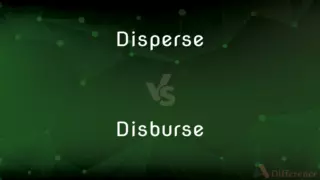Titrant vs. Analyte — What's the Difference?
By Tayyaba Rehman — Updated on September 18, 2023
A titrant is the solution of known concentration used in titration. The analyte is the substance whose concentration is being determined in the titration.

Difference Between Titrant and Analyte
Table of Contents
ADVERTISEMENT
Key Differences
In the realm of chemistry, titration is a fundamental analytical procedure used to determine the concentration of a specific substance in a sample. The titrant is the solution with a known concentration that's added to a given volume of another solution to determine its concentration. On the other hand, the analyte is the substance in the sample whose concentration is being determined.
Tayyaba Rehman
Sep 18, 2023
In essence, while both the titrant and analyte play crucial roles in titration, their functions are distinct. The titrant provides a reference point with its known concentration, while the analyte's concentration remains the mystery to be uncovered.
Tayyaba Rehman
Sep 18, 2023
It's pivotal that the concentration of the titrant is known accurately because this information is used to determine the concentration of the analyte. If the titrant's concentration is off, the calculated concentration of the analyte will also be inaccurate.
Tayyaba Rehman
Sep 18, 2023
When performing a titration, the titrant is typically delivered from a burette into the analyte until the reaction between them is complete. This endpoint can be identified visually with an indicator or by some instrumental means. The volume of titrant used gives insights about the concentration of the analyte.
Tayyaba Rehman
Sep 18, 2023
In summation, a successful titration hinges on the precise interplay between the titrant and the analyte. Mastery of this technique enables chemists to accurately determine concentrations, which is vital in many scientific and industrial applications.
Tayyaba Rehman
Sep 18, 2023
ADVERTISEMENT
Comparison Chart
Definition
Solution with known concentration used in titration.
Substance in a sample whose concentration is being determined.
Tayyaba Rehman
Sep 18, 2023
Role in Titration
Added to the sample to react with the analyte.
Reacts with the titrant during titration.
Tayyaba Rehman
Sep 18, 2023
Delivery
Typically delivered from a burette.
Present in the sample container or flask.
Tayyaba Rehman
Sep 18, 2023
Purpose
Provides a reference point for determining the concentration of another substance.
The substance of interest; its concentration is the goal of the titration.
Tayyaba Rehman
Sep 18, 2023
ADVERTISEMENT
Definitions
Titrant
The reagent added from a burette to a solution to determine its concentration.
The blue color vanished as the titrant reacted with the solution.
Tayyaba Rehman
Sep 18, 2023
Analyte
The substance or chemical being analyzed or detected in a sample.
The lab technician looked for traces of the analyte in the water sample.
Tayyaba Rehman
Sep 18, 2023
Titrant
A solution of known concentration used in titrations.
The chemist carefully measured the titrant before starting the procedure.
Tayyaba Rehman
Sep 18, 2023
Analyte
The compound of interest in analytical chemistry procedures.
The concentration of the analyte was higher than expected in the serum.
Tayyaba Rehman
Sep 18, 2023
Titrant
The standardized solution in titration.
She made sure the titrant was freshly prepared for accuracy.
Tayyaba Rehman
Sep 18, 2023
Analyte
The target molecule or ion in a chemical analysis.
The test kit was designed to specifically detect the analyte in question.
Tayyaba Rehman
Sep 18, 2023
Titrant
The known component in a titration procedure.
The volume of titrant used helped determine the end point of the titration.
Tayyaba Rehman
Sep 18, 2023
Analyte
The component in a sample subjected to quantitative or qualitative analysis.
Once the analyte was isolated, further tests were conducted to verify its properties.
Tayyaba Rehman
Sep 18, 2023
Titrant
The solution used as a reference in titrimetric analysis.
Without a properly standardized titrant, the experiment would be flawed.
Tayyaba Rehman
Sep 18, 2023
Analyte
The unknown component in titration whose concentration is being determined.
The color change indicated that the analyte had completely reacted.
Tayyaba Rehman
Sep 18, 2023
Titrant
A substance, such as a solution, of known concentration used in titration.
Tayyaba Rehman
Apr 15, 2018
Analyte
An analyte, component (in clinical chemistry), or chemical species is a substance or chemical constituent that is of interest in an analytical procedure. The purest substances are referred to as analytes.
Tayyaba Rehman
Apr 15, 2018
Titrant
(analytical chemistry) The reagent of known concentration and volume used in titrations.
Tayyaba Rehman
Apr 15, 2018
Analyte
A substance whose chemical constituents are being identified and measured.
Tayyaba Rehman
Apr 15, 2018
Analyte
A substance or sample being analyzed, usually by means of a laboratory procedure or test.
Tayyaba Rehman
Apr 15, 2018
FAQs
Can the roles of titrant and analyte be reversed?
In principle, yes. What is titrant in one experiment could be analyte in another, depending on the procedure's design.
Tayyaba Rehman
Sep 18, 2023
How do you identify the endpoint of a titration?
The endpoint is when the titrant has fully reacted with the analyte, often indicated by a color change or instrument reading.
Tayyaba Rehman
Sep 18, 2023
Why is the concentration of the titrant so critical?
The known concentration of the titrant allows for accurate determination of the analyte's concentration.
Tayyaba Rehman
Sep 18, 2023
Are titrant and analyte specific to a certain type of titration?
No, these terms apply to all types of titration, whether acid-base, redox, or others.
Tayyaba Rehman
Sep 18, 2023
What happens if too much titrant is added?
Over-adding titrant overshoots the endpoint, leading to inaccurate results about the analyte's concentration.
Tayyaba Rehman
Sep 18, 2023
What is the main function of the titrant in titration?
The titrant is used as a reference solution with a known concentration to determine the concentration of an analyte.
Tayyaba Rehman
Sep 18, 2023
Why is it important to note the volume of titrant used?
The volume of titrant used, combined with its concentration, allows for calculation of the analyte's concentration.
Tayyaba Rehman
Sep 18, 2023
How do you prepare a titrant for titration?
A titrant is typically prepared by dissolving a known amount of solute in a solvent and then standardizing it to confirm its concentration.
Tayyaba Rehman
Sep 18, 2023
What happens if the titrant's concentration is wrong?
An incorrect titrant concentration will lead to inaccurate determination of the analyte's concentration.
Tayyaba Rehman
Sep 18, 2023
Can multiple analytes be determined in a single titration?
Yes, but it requires careful procedure design and may involve multiple titrants or steps.
Tayyaba Rehman
Sep 18, 2023
Can any solution be used as a titrant?
No, the titrant should react specifically and completely with the analyte for accurate titration results.
Tayyaba Rehman
Sep 18, 2023
Can an analyte be a gas?
Yes, while analytes are often liquids or solids, gases can also be analyzed using specific titration techniques.
Tayyaba Rehman
Sep 18, 2023
Are all titrants liquids?
While most commonly liquid, solid titrants exist and can be used in specific titration procedures.
Tayyaba Rehman
Sep 18, 2023
How is the concentration of an analyte determined after titration?
By using the volume of titrant required to reach the endpoint and its known concentration, the concentration of the analyte can be calculated.
Tayyaba Rehman
Sep 18, 2023
Is it always necessary to use an indicator in titration?
Not always. While indicators help visually determine the endpoint, some titrations use instruments to detect when the titrant has fully reacted with the analyte.
Tayyaba Rehman
Sep 18, 2023
Author Spotlight

Written by
Tayyaba RehmanTayyaba Rehman is a distinguished writer, currently serving as a primary contributor to askdifference.com. As a researcher in semantics and etymology, Tayyaba's passion for the complexity of languages and their distinctions has found a perfect home on the platform. Tayyaba delves into the intricacies of language, distinguishing between commonly confused words and phrases, thereby providing clarity for readers worldwide.

















































